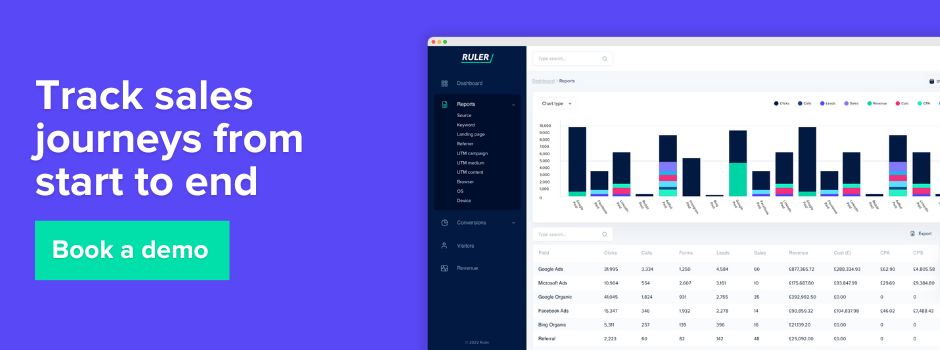Improving your sales numbers through good marketing requires data. Sales tracking software can help you plug that data gap and start making data-driven decisions.
40% of marketers said that better data would help them improve their marketing.
And they’re not wrong.
When you’re struggling with long customer journeys, hard-to-track marketing touchpoints and offline conversions, it can be hard to know where to begin when it comes to getting better data.
But, there is a solution.
With the right sales tracking tools in place, you can make sense of your data without any hard work or Excel spreadsheets.
In this blog, we’ll go through:
💡 Say goodbye to blind spots in the sales journey
Ruler tracks every step of the customer’s journey, from the very first touchpoint to the final conversion, allowing you to pinpoint the exact ads, campaigns, and keywords that drive the most valuable sales. Skip straight to a demo here
Sales tracking software is any software tool that allows businesses to better understand their sales results and activity.
Sales tracking tools can help you better understand your target audiences, how marketing influences revenue and identify sales pipeline problems.
With these tools in place, you’ll have more data at your disposal to make smarter decisions about your sales and marketing activity.
There are many sales tracking software options out there, each with different features for your sales team. The variety of choices can make it challenging to pick the right one for your business. However, the ideal tool should allow you to do the following things.
For optimal performance, your sales and marketing teams should share goals and KPIs. In many B2B setups, marketers often focus on lead generation, while sales handles deal closures. This siloed approach leads to marketing not being directly accountable for revenue, and sales lacking data to assess lead quality.
Related: How to achieve sales and marketing alignment
The sales tracking tool you opt for should help your sales and marketing teams work together smoothly. This means easy sharing of information on leads, prospects, and ongoing campaigns.
Customer journeys are getting longer and longer. Gone are the days of landing on a website and converting for the first time.
The right tool can offer data to track where your leads come from and follow how customers interact with your business. This includes monitoring touchpoints from initial engagement to conversion. By understanding the entire customer journey, your marketing and sales teams can refine strategies, focusing on the most effective channels for lead and revenue generation.
💡 Pro tip: Ruler tracks how visitors, leads and sales interact with your brand across different touchpoints and channels like email, social media, and paid ads, allowing you to uncover a hidden map of your customer journey. See how Ruler tracks the view customer journey here.
Forecasting revenue can help you predict how much money your business is making (and can make). A reliable tool should include predictive analytics for accurate revenue forecasting.
Related: How to track and forecast revenue with Ruler
This helps set realistic sales targets, allocate resources efficiently, and identify areas for improvement. With a clear understanding of historical data and current trends, your team can make more accurate projections for the future.
So, now you know what to look for in sales tracking software, let’s see which ones should be at the top of your list.
According to a survey, 44% of participants reported using between 5 and 10 tools within their tech stack. It’s crucial to select a sales tracking tool that easily connects with your CRM software, analytics and marketing automation platform for seamless reporting, less manual work, and a complete view of sales and marketing efforts.
So, now you know what to look for in sales tracking software, let’s see which ones should be at the top of your list.
The potential benefits of sales tracking software are numerous, so let’s look at some options you should consider.
Remember, not all of these will solve every issue you might be facing.
It might be a case of upgrading a number of tools in your marketing and sales tech stack to ensure you have a well-rounded selection.
To help, we pulled out 9 of our favourite sales tracking tools:
Call us biased, but Ruler is a great tool to better understand where your sales are coming from and how to drive more meaningful results for your business.
Ruler is a marketing attribution tool that tracks sales by following every step of a user’s journey, even when they’re anonymous. It links these touchpoints to eventual conversions, for example, when a user fills out a form.
By integrating with your CRM tool, Ruler adds details like where your leads or sales come from, like what channels, ads, campaigns and landing pages they interacted with to find your business. When a visitor becomes a customer, Ruler sends this revenue data back to its dashboard to show which marketing sources are most effective. This way, you can see what works best and improve your strategies to drive more sales.
Ruler also goes beyond the status quo of attribution that focuses only on click-path data and uses marketing mix modelling to uncover invisible touchpoints influencing customer journeys and sales. This helps predict the point of diminishing returns accurately, allowing you to optimise your marketing budget for maximum ROI.
Here are the key product features of Ruler to help track your sales:
Pricing for Ruler starts at £199 a month and it has various plans to suit your specific needs. You can save 20% by paying annually and there are special rates for agency partners.
💡 Pro tip: Curious about Ruler and its extensive range of features? Secure a demo to see Ruler in action and discover how it showcases the impact of your marketing strategies on sales and revenue. Book a demo of Ruler
Bitrix24 links your sales and marketing data so you can correlate marketing spend back to sales results. It gives you a clear understanding of your sales conversion rate so you can best optimise your sales processes.
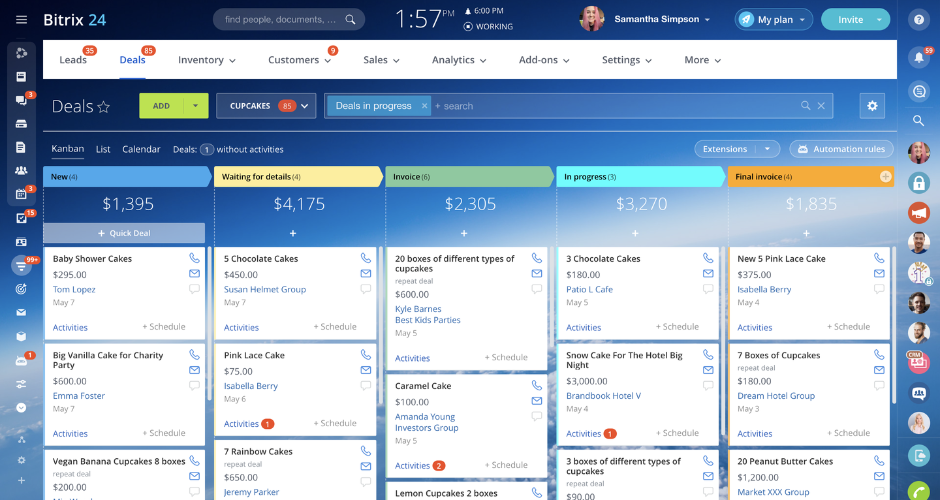
Bitrix24 also offers a whole host of other tools and features that can support other teams and business requirements, but if you’re just looking for sales tracking, then this is a valid option.
Pricing varies depending on features and user count, starting at $540 for a self-hosted version or $32 per user per month for cloud-based plans.
EngageBay is a great sales tracking tool used by many small businesses. It actually also offers a free forever package too if you’re only dealing with low numbers of contacts.
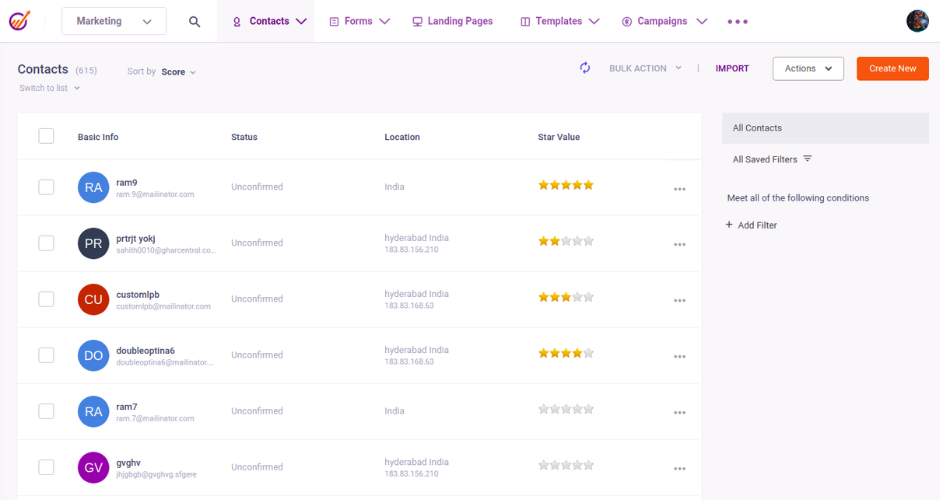
This tool integrates seamlessly with Gmail and Office 365 to better sync inbound and outbound emails to leads and customers. It also offers SMS broadcasting, automated emails and multiple deal pipelines.
EngageBay offers both free and paid plans, starting from $0 and scaling up to custom pricing for larger teams.
FreshSales is another popular CRM and sales tracking tool. It provides users with a 360 view of their leads and customers and vital statistics like conversion rate and demographic stats.
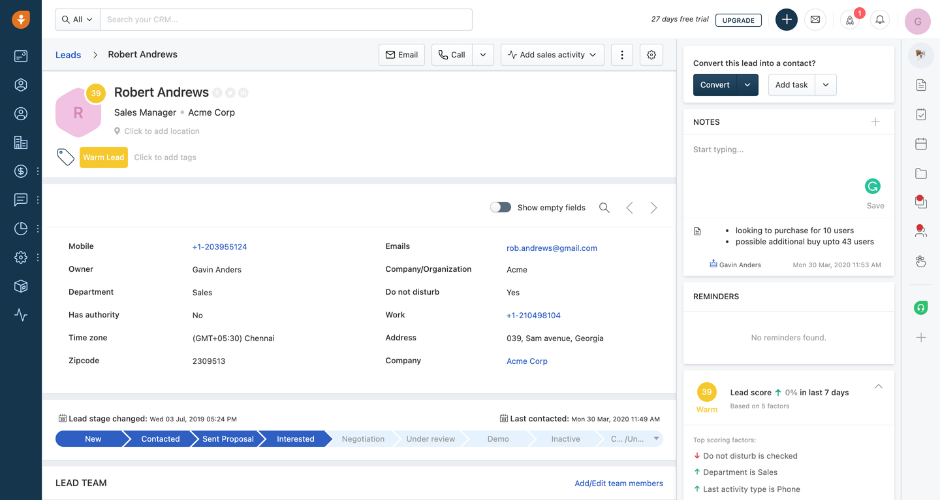
For simple lead and sales tracking, FreshSales offers a free version which is a great option. But for more dashboard capabilities and more options with automation, then you would need to upgrade your plan. Prices start at £12 per month for their paid plan.
HubSpot is another fantastic CRM tool that doubles as sales tracking software. With a robust CRM system as well as built- tools for marketing teams, HubSpot is a fantastic option for larger businesses.
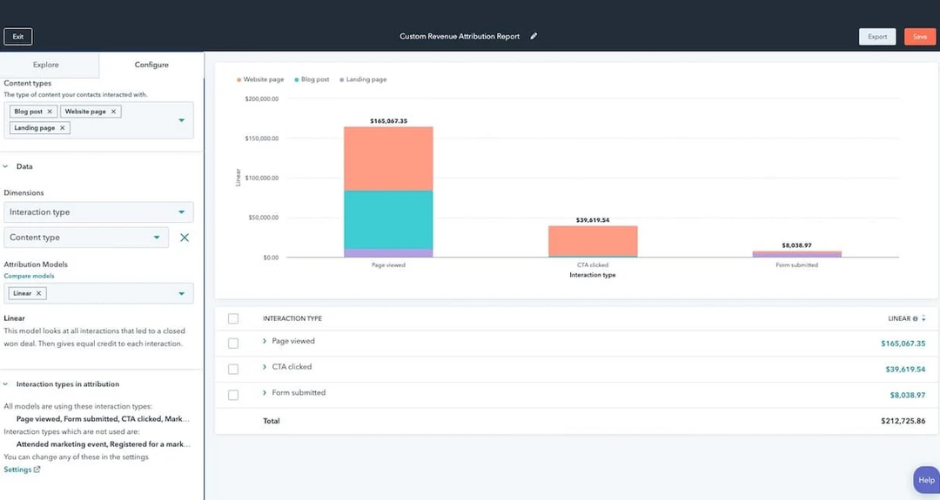
HubSpot does come at a price but it can offer functionality like sales pipeline management and automation. It’s also great for activity logging where you can analyse sales rep activity against results and quota.
Similar to Ruler, HubSpot offers attribution features, but these are included in the enterprise package, which begins at a monthly cost of £2000.
Related: Ruler vs HubSpot: Comparison and analysis
HubSpot offers a free tool but this is a very rudimentary version of the full application. Paid plans for sales start at £38 per month.
Nutshell offers a wide range of sales tracking tools that can benefit your business. You can quickly forecast your revenue, get clear insight on how current sales compare to your quota and correlate activity to your sales reps.
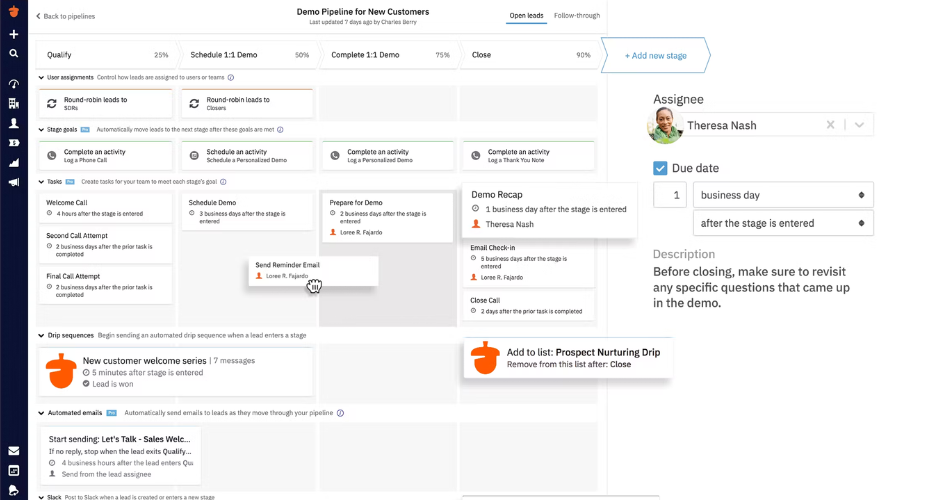
Alongside these important sales reporting capabilities, Nutshell also allows you to create automated sales messaging and contact management.
Nutshell CRM starts at $19 per user per month for their starter plan, offering powerful features for solopreneurs and small teams.
Pipedrive, like a number of other tools on this list, is an all-encompassing CRM tool. While it does offer sales tracking software, it’s more widely used as a general CRM.
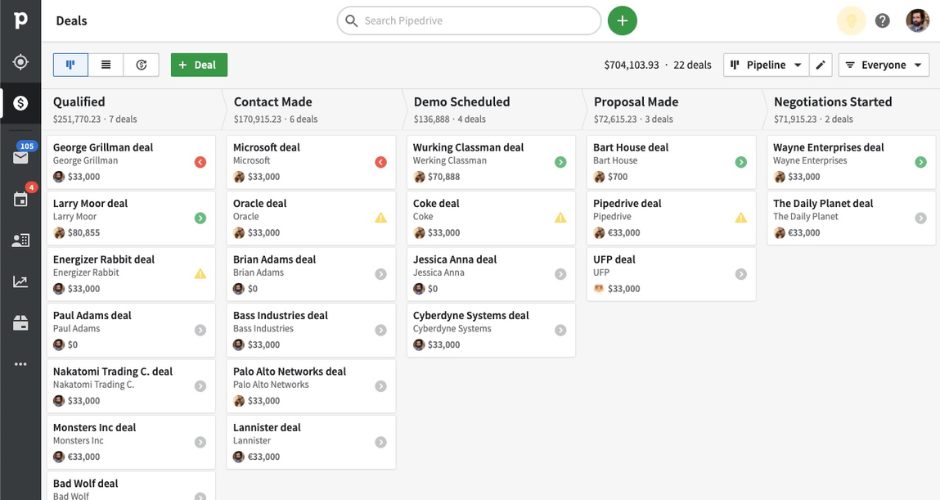
With Pipedrive in play, you can expect better lead management and lead nurturing as well as pipeline automation.
For example, they offer a tool where sales reps will be notified if a lead has been sat stagnant for too long.
Prices for Pipedrive start at £14.90 per month for the Essential plan, but this doesn’t include all of their sales tracking features.
For more efficient sales tracking, you should definitely consider Salesflare. This sales CRM allows users to keep track of leads and customers by correlating information from other sources.
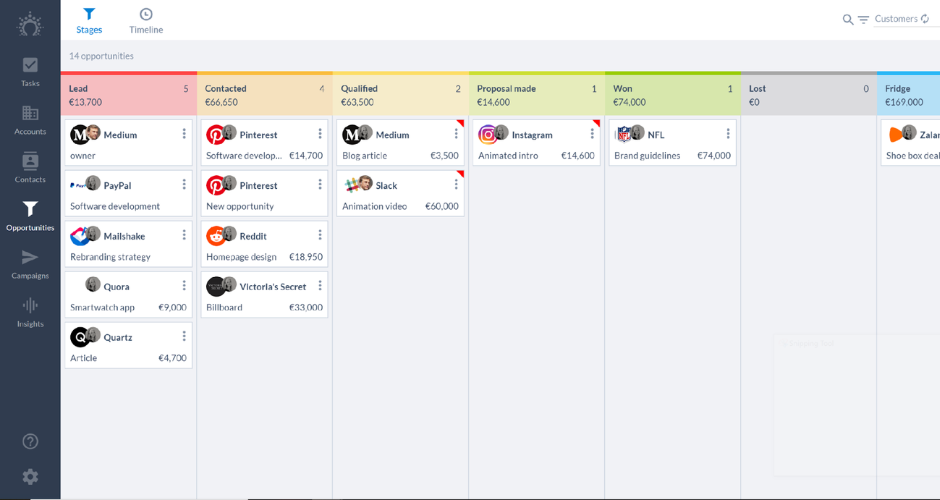
It offers a range of reports and dashboards to better understand your current performance and also supports sales reps to better nurture their leads and opportunities with features like automatic follow-up notifications and email signature syncing.
Saleflare starts at $29 per user per month if billed annually, or $35 billed monthly. This includes standard CRM features like automated data entry, email and link tracking, and a mobile app.
Zoho CRM offers advanced sales tracking reporting to better understand the full sales cycle.
You can create bespoke dashboards for key stats on sales and leads including options for target meters and funnels.
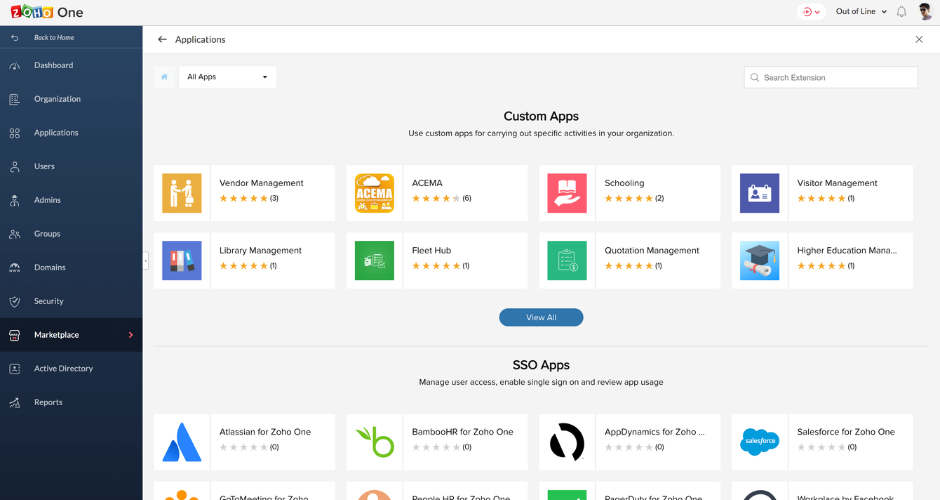
Since this tool is also a CRM, you can easily blend data hosted within your CRM for a deeper understanding of your sales performance. You can also automate your workflows for easier sales processing.
Zoho has several pricing plans depending on the specific software and features you need, ranging from free trials and freemium tiers to individual user plans starting at $3 or $5 per month, up to custom enterprise plans for larger teams.
Improving your sales results can often feel like an uphill battle, but remember. The first step to improving your results is to assess where you are right now.
By getting valuable data flowing, you can make data-driven decisions that will positively impact your bottom line.
For us, it’s using Ruler and attribution. With it in play, we’ve been able to quickly identify which initiatives are driving the best-quality leads. We’ve also identified content that drives leads but isn’t converted – which has helped us further refine our sales pitches.
By seeing data laid out in a clear, easy to understand format, you can better track your sales activity and understand the opportunities that will most likely result in reward.
Book a demo of Ruler Analytics to see attribution data in action. Or, learn more about why you need to implement an attribution tool like ours into your tech stack.
